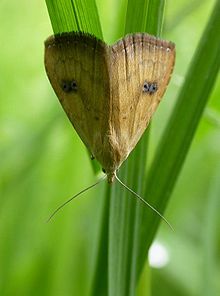Silk owls
| Silk owls | ||||||||||||
|---|---|---|---|---|---|---|---|---|---|---|---|---|

Silk owl ( Rivula sericealis ) |
||||||||||||
| Systematics | ||||||||||||
|
||||||||||||
| Scientific name | ||||||||||||
| Rivula sericealis | ||||||||||||
| ( Scopoli , 1763) |
The silk owl ( Rivula sericealis ) is a butterfly ( moth ) from the family of the owl butterflies (Noctuidae).
features
butterfly
The moths reach a wingspan of 18 to 22 millimeters. They have light yellowish forewings that have a silky sheen and are somewhat darkened in front of the hem. The kidney flaw is dark and double core black. Cross lines are brownish, but often only weakly pronounced. The hind wings are white-gray to gray. The palps are slightly bent upwards, there is a proboscis .
egg
The egg is yellowish, hemispherical and covered with many straight longitudinal and transverse ribs. About half of the approx. 40 longitudinal ribs reach the micropyl zone .
Caterpillar
Adult caterpillars are short and thick, green in color, with broad white side ridge lines. There are strong, short hairs on the point warts.
Doll
The pupa is green and shows white vertical stripes. The Kremaster has short, curved bristles.
Geographical distribution and habitat
The rivula sericealis is from North Africa across the Iberian Peninsula to southern Fennoscandia widespread and often some regions. In an easterly direction the species occurs as far as the Pacific Ocean . She lives in different habitats. These include moist grasslands, ruderal areas , light forests, alder forests and settlement areas.
Way of life
The moths sometimes fly during the day, at dusk and into the night. The silk owl forms two generations a year, which fly from late May to early July and from mid-July to early October. To what extent the very late-flying moths belong to a third generation needs further clarification. During the day they like to rest on blades of grass, typically sitting upside down. Sometimes they suckle on the flowers of Dost ( Origanum ) or goldenrod species ( Solidago ). They are easily attracted by artificial light . Their caterpillars feed on a wide variety of grasses and overwinter.
Danger
The silk owl is not endangered in Germany.
swell
Individual evidence
- ^ A b Walter Forster , Theodor A. Wohlfahrt : The butterflies of Central Europe. Volume 4: Owls. (Noctuidae). Franckh'sche Verlagshandlung, Stuttgart 1971, ISBN 3-440-03752-5 .
- ↑ a b Günter Ebert (Ed.): The Butterflies of Baden-Württemberg Volume 5, Moths III (Sesiidae, Arctiidae, Noctuidae). Ulmer Verlag Stuttgart 1997. ISBN 3-8001-3481-0
literature
- Günter Ebert (Ed.): The Butterflies of Baden-Württemberg Volume 5, Moths III (Sesiidae, Arctiidae, Noctuidae). Ulmer Verlag Stuttgart 1997. ISBN 3-8001-3481-0
- Manfred Koch : We determine butterflies. Volume 3: Owls. 2nd, expanded edition. Neumann, Leipzig / Radebeul 1972, DNB 760072930 .
Web links
- www.lepiforum.de Taxonomy and photos
- www.Insektenbox.de
- Moths and Butterflies of Great Britain and North Africa (English)
- Ian Kimber: Guide to the moths of Great Britain and Ireland (English)
- www.schmetterlinge-deutschlands.de Endangerment
- Rivula sericealis at Fauna Europaea. Retrieved January 25, 2013

